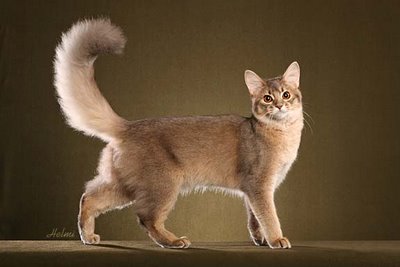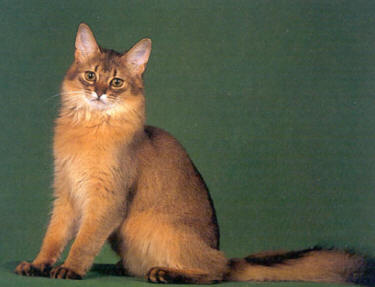The Somali first originated in the nineteen sixties when a breeder in Canada saw a longhaired Abyssinian and fell in love with its look. The breeder decided to breed the longhaired kitten back to an Abyssinian which resulted in kittens that closely resembled the Abyssinian, but with a beautiful longhaired coat.
With the creation of these wonderful new cats, it is no surprise that their popularity soared quite quickly. This rapid interest soon spread to the United States as well as Europe. The Somali is also known in the cat fancier’s realm as the Longhaired Abyssinian as this is the only breed used to create the Somali.
Appearance
The physical characteristics of a Somali include a wedge shaped head, large ears, enormous expressive eyes, a long, plush tail and a well toned, muscular body. One of the most fascinating characteristics these cats display is their unique facial markings around the eyes.
The Somali’s eyes appear to be outlined in a dark kohl color, while the outside of this dark color is shaded in a light colored fur. Many cat fanciers have commented that these elegant cats look as if they are wearing stage makeup with a pair of eye glasses. These lovely cats come in Ruddy, Chocolate, Sorrel, Red, Blue, Lilac, Fawn and cream colors, with Tabby, Tortoiseshell tabby, or Silver Tabby patterns also being available.
Health Problems and Grooming
A regular grooming regiment is essential for keeping the Somali’s hair looking plush and beautiful. A routine of brushing and combing about once or twice a week should be sufficient for removing loose hair, debris and dander. It is important to note that owners must pay particular close attention to the ruff of hair around the neck and the tail, as these areas of hair are longer than the rest of the coat and can become tangled and gnarled rather quickly.
A well groomed cat is a happy cat. A regular grooming regiment also helps to assist in preventing the onset of hairballs. The Somali is a very healthy breed with exception of a few instances of hairballs. Upon your visit with a veterinarian for your cats physical and vaccinations, consult with him about which brand of specially formulated hairball preventative food is best for you and your cat.
Behavior and Characteristics
Just as its descendants the Abyssinian, the Somali is a very playful and loving cat. This makes this breed perfect for family homes as well as homes with multiple cats. Since these cats are so playful, they need a wide variety of toys to stimulate them.
However, these clever cats have the ability to make any old thing an amusing toy. Paper bags, old boxes, string and feathers are all great toys to keep your cat happy without emptying your wallet. The Somali is a very social breed and is happy to play with its owners or just snuggle up in your lap for a relaxing evening in front of the television.
If your career demands that you spend long hours away from home, you may want to consider an alternative breed that is more self-contained. However, if your heart is set on owning one of these cute Somali’s, you should definitely consider adding another kitten to the home to keep your Somali from becoming sad and lonely.
In addition to these already endearing qualities, the Somali is a very highly intelligent breed of cat. This breed can be taught many tricks including fetch, coming when his name is called and walking on a leash.
Anyone who wants a cat with a unique and distinctive look, combined with a loving and playful personality, is certainly going to want to take a look at the beautiful and wonderful Somali.
With the creation of these wonderful new cats, it is no surprise that their popularity soared quite quickly. This rapid interest soon spread to the United States as well as Europe. The Somali is also known in the cat fancier’s realm as the Longhaired Abyssinian as this is the only breed used to create the Somali.
Appearance
The physical characteristics of a Somali include a wedge shaped head, large ears, enormous expressive eyes, a long, plush tail and a well toned, muscular body. One of the most fascinating characteristics these cats display is their unique facial markings around the eyes.
The Somali’s eyes appear to be outlined in a dark kohl color, while the outside of this dark color is shaded in a light colored fur. Many cat fanciers have commented that these elegant cats look as if they are wearing stage makeup with a pair of eye glasses. These lovely cats come in Ruddy, Chocolate, Sorrel, Red, Blue, Lilac, Fawn and cream colors, with Tabby, Tortoiseshell tabby, or Silver Tabby patterns also being available.
Health Problems and Grooming
A regular grooming regiment is essential for keeping the Somali’s hair looking plush and beautiful. A routine of brushing and combing about once or twice a week should be sufficient for removing loose hair, debris and dander. It is important to note that owners must pay particular close attention to the ruff of hair around the neck and the tail, as these areas of hair are longer than the rest of the coat and can become tangled and gnarled rather quickly.
A well groomed cat is a happy cat. A regular grooming regiment also helps to assist in preventing the onset of hairballs. The Somali is a very healthy breed with exception of a few instances of hairballs. Upon your visit with a veterinarian for your cats physical and vaccinations, consult with him about which brand of specially formulated hairball preventative food is best for you and your cat.
Behavior and Characteristics
Just as its descendants the Abyssinian, the Somali is a very playful and loving cat. This makes this breed perfect for family homes as well as homes with multiple cats. Since these cats are so playful, they need a wide variety of toys to stimulate them.
However, these clever cats have the ability to make any old thing an amusing toy. Paper bags, old boxes, string and feathers are all great toys to keep your cat happy without emptying your wallet. The Somali is a very social breed and is happy to play with its owners or just snuggle up in your lap for a relaxing evening in front of the television.
If your career demands that you spend long hours away from home, you may want to consider an alternative breed that is more self-contained. However, if your heart is set on owning one of these cute Somali’s, you should definitely consider adding another kitten to the home to keep your Somali from becoming sad and lonely.
In addition to these already endearing qualities, the Somali is a very highly intelligent breed of cat. This breed can be taught many tricks including fetch, coming when his name is called and walking on a leash.
Anyone who wants a cat with a unique and distinctive look, combined with a loving and playful personality, is certainly going to want to take a look at the beautiful and wonderful Somali.




 RSS Feed
RSS Feed